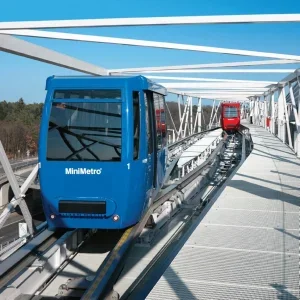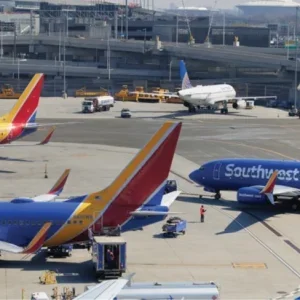It is no secret that flying can be stressful for passengers. Aside from whatever happens in the air, they are often asked to contend with long queues for security, rushes to make connections, or unforeseen delays.
These issues may be intensified in large international airports, which handle travellers from every corner of the world. An unfamiliar terminal can be a daunting place to be, particularly if you don’t speak the local language. There are substantial customer service challenges for frontline staff. More so than, say, their counterparts in traditional hospitality environments, airport workers must be well equipped to manage anxiety, fear and frustration, overcome obstacles to communication, deal with problem passengers and take care of those with special needs.
“For some passengers, especially firsttime flyers, travelling can be stressful. It is our job to ease this and help them have an enjoyable experience,” says Tonia Fielding, head of customer relations and service at Heathrow Airport. “For others, it can be a very exciting time, and they need different advice or support. Frontline teams must be able to anticipate and adapt to varying needs.”
No worries
As a major hub airport, Heathrow typically handles more than 70 million passengers a year, averaging more than 200,000 a day. Of these, many require special assistance – aside from all those who do not speak English, 1.2 million have reduced mobility, and others have disabilities that may not be immediately obvious. The challenge for airports is to accommodate rising numbers of travellers in a way that removes as much worry as possible from the equation.
Of course, this is no easy task given the numbers involved. A passenger is likely to deal not just with airport representatives, but also staff from the airline and a host of subcontractors, but they are unlikely to have a clear idea of who is responsible for what, perceiving all the staff in the terminal as part of an integrated whole.
Airports must therefore offer seamless customer service, starting with the moment a passenger enters the terminal building (or beforehand) and ending with the moment they board their plane. A service issue at any point along the way is likely to ruin satisfaction across the board.
The key is to break down the passenger journey into touchpoints – moments of interaction between the customer and the service you provide. Heathrow has roaming ‘passenger ambassadors’ who provide information and assistance throughout the terminal, and create a sense of constancy from one touchpoint to the next.
“Passenger ambassadors are at every touchpoint that a traveller may need help to make a decision,” says Fielding. “They play an important role in providing support to everyone that needs it. They are able to provide flight information, directions or shopping advice or even recommend a restaurant before they board.”
These helpers are not only airport experts, but they are also equipped with the latest mobile communication tools to help them answer any questions, fast.
“They are able to use technology as a means by which to communicate to passengers, or to help with tasks such as rebooking,” says Fielding.
“Face-to-face conversations are always vital in times of disruption, so they provide a visible presence and leadership during any incident.”
Friendly faces
This kind of personalised service is imperative even in an age of digital check-in and airline apps. While new technology has had a major impact on passengers’ experiences, they should ideally be viewed as a complement to, rather than a substitute for, interactions with staff. Two thirds of travellers, after all, fly fewer than five times a year, so many won’t be particularly familiar with modern self-service systems.
Although the likes of self-check-in and self-luggage tagging can save a lot of time and hassle, many customers still desire practical assistance and a reassuring face.
As Annegret Reinhard-Lehmann of Frankfurt Airport said at the Passenger Terminal Expo 2013, “Self-service puts passengers in control of their journeys. However, airports must never forget that percentage of passengers who are uncomfortable with new technology, and must ensure that enough human support is available at all times.”
In this sense, airports can take their cues from hospitality companies, which also try to strike a balance between new technological possibilities and the need for a personal touch. While airports have many additional factors to bear in mind – not least issues pertaining to safety – they should not forget their role as service providers, or the benefits that can be reaped from a more customer-centric approach.
This comes across in many airport training programmes, which mirror those used in the hospitality industry.
“Heathrow’s team strives constantly to deliver the best airport service in the world, and will continue to improve by investing in better connecting journeys, offering a more personalised and friendly service, and welcoming exciting new retail and hotel options,” says Fielding.
The upshot is likely to be increased revenue. According to SITA’s report, ‘Towards 2020 and Beyond’, passengers reporting high levels of satisfaction with the airport spent an average of 45% more than those who were ‘disappointed’. It’s not a figure to take lightly; at a time when airports face such thin margins, non-aeronautical revenue has become a key determinant of success.
Airports, then, need to think about all aspects of the equation, from speeding up the arrivals process to entertaining passengers during their discretionary time.
“Last year was really exciting at London Heathrow, with a wave of new luxury lounges across all terminals, including the opening of Terminal 5’s first-ever personal shopping lounge,” says Fielding.
“In 2017, the team is looking forward to giving passengers an even better experience, with construction starting on Terminal 2’s own hotel and the reopening of Gordon Ramsay’s Plane Food in Terminal 5 after an extensive refurbishment.”
As customers in general become better travelled, and more able to pit one airport against the next, these kinds of services look set to become a strong differentiator. Today’s passengers don’t just view an airport as a means of getting from A to B, they also expect an efficient, immersive and even enjoyable experience.
It is no wonder that quantifying customer satisfaction has become a major concern. Independent agencies such as Skytrax and the Airport Council International gather customer service feedback from airports around the globe, while airports may also use mystery shoppers and exit surveys.
“Of course, the tried-and-tested growth in numbers is also key, as passengers have choice,” points out Fielding. “If they are not satisfied, they will speak with their feet.”
She feels that, as time goes by, passengers’ expectations will keep rising. This is fuelled in part by the changes in other industries (for example, banking and retail), in which service is becoming ever more personalised and convenient.
Reassure and excite
Airports will also need to remain mindful of changing passenger demographics, particularly when helping those with special needs.
While in the past, those with neurodevelopmental challenges might have been viewed merely as ‘problem’ passengers, airports are now recognising that such travellers comprise a significant proportion of their customer base. Shannon Airport, for instance, recently became the first in Europe to offer a ‘sensory room’ for autistic passengers designed to reduce their stress. At Heathrow, too, the issue is uppermost on staff’s minds.
“An upward trend is expected in hidden disabilities, such as dementia and autism, and an ageing population is also expected to be reflected in the changing demographic of passengers,” says Fielding. “Work is already under way to tailor the service to meet the changing needs of customers.”
It may never be possible to eradicate airport stress entirely. No matter how great your customer service, many variables remain that cannot be controlled, and ensuring safety will always be more important than, say, cutting queuing times. However, as customer expectations evolve, the travel experience needs to adapt accordingly and front-line staff play a crucial role.
“Every journey through Heathrow should reassure and excite in equal measure,” says Fielding. “This is about understanding that different passengers need different things, making the environment as stress-free as possible, and ensuring that the team is confident and able to recognise and anticipate those needs.”






